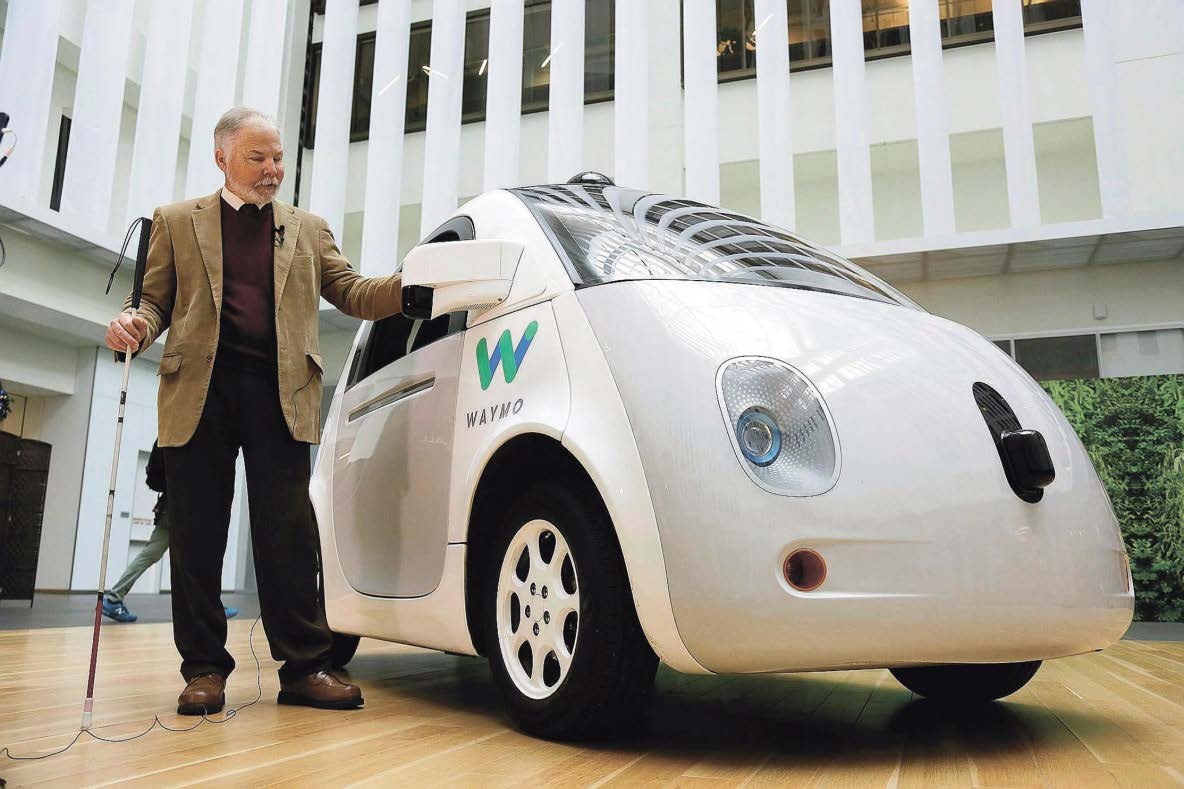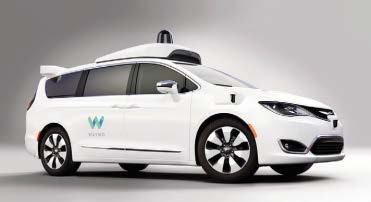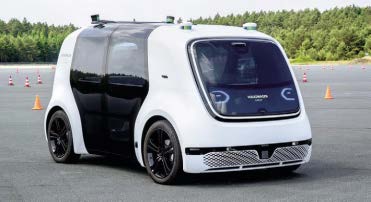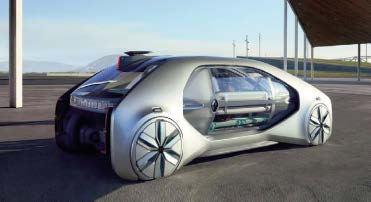
BLIND FAITH: Steve Mahan, who is legally blind, was the first non-Google employee to ride alone in the company's gumdrop-shaped autonomous car.
GETTING THERE
WILL THE ERA OF DRIVERLESS CARS MOBILIZE THOSE WITH DISABILITIES?
BY EP STAFF
For people with disabilities, mobility and transportation issues are one of the most difficult barriers they face in their struggle for accessibility and inclusion. Without a reliable system of friends and family, or the ability to pay for Lyft, Uber or conventional taxis, people with special needs are reduced to relying on public transportation, which is often not accessible, dependable or convenient.
Stuck In Neutral
Over 25 million people in the U.S. have disabilities that make traveling outside the home difficult, and they make fewer trips on average than those without disabilities, regardless of age, according to the U.S. Department of Transportation's 2017 National Household Travel Survey ( nhts.ornl.gov). Seven out of 10 people surveyed in the NHTS said they reduce day-to-day travel because of their disabilities, and one-third of people who made zero trips said they stayed home because they're severely disabled or housebound.
Predictably, people with disabilities are more likely to encounter obstacles with nearly every mode of transportation. In a 2003 survey conducted by the U.S. Department of Transportation ( ncbi.nlm.nih.gov/books/NBK11420), nearly 20% reported that their disability makes transportation difficult to use, with limited public transportation being the most frequent complaint. However, progress in the field of autonomous, or self-driving cars over the last decade or so is a promising development for those with mobility, vision, and hearing impairments, including seniors and those with chronic health conditions. If autonomous cars are developed with inclusivity as a primary goal, experts say the societal benefits could be enormous. For a segment of society that has been severely limited in its ability to move around, the prospect of easier access and increased independence that could one day become reality is an exciting one.
A 2017 Ruderman Foundation study found that mitigating transportation obstacles would enable employment opportunities for two-million people with disabilities.1 And since approximately 4.3 million people with a disability face significant transportation barriers when attempting to travel to their medical appointments, autonomous automobiles could potentially save $19 billion annually from missed medical appointments. Another potential impact of inclusive transportation is an increase in civic participation. A 2013 study by the Research Alliance for Accessible Voting argues that 3 million more people would have voted in the 2012 U.S. elections if those with disabilities voted at the same rate as those without.2
Technology Drivers
Perhaps the highest profile autonomous driving technology project in the U.S. today is Google's Self-Driving Car Project, started in 2009 and now named Waymo. Waymo, whose name was derived from its mission, "a new way forward in mobility," is a technology company working to make it safe and easy for people and things to get where they're going. Waymo is focused on improving everyone's access to mobility, while saving thousands of lives now lost to traffic crashes.
In October 2015, Waymo achieved the world's first fully self-driving trip on public roads in Austin, TX., in a car without a steering wheel or pedals. Waymo refines their technology through one billion miles of simulation testing each year, and the cars have self-driven over two-million miles on public roads across four U.S. cities.3
Steve Mahan, 63, of San Francisco, has worked extensively with Google since the project's early days. The executive director of the Santa Clara Valley Blind Center was the car's first passenger when the company tested its first autonomous ride in 2015. Over the course of its research and development, Waymo's vehicles have carried a number of disabled passengers.
Mahan had been gradually losing his vision over the last decade. He recalled experiencing the transition from using vehicles with driver-assistance systems to fully autonomous driving. "I had been in the Priuses and the Lexus vehicles that were adapted for autonomous driving, and they had normal control features. This was just to me the next logical step: to remove the human from the equation altogether," Mahan said.
Mahan hints at a new world of possibilities that are the aim of this research. "I miss driving," he said. "My experience with Google has been terrific, and I want it to happen. Everyone in the blind community wants it to happen. There are few things more American than getting in your car." Waymo is engaged with several collaborators, including the Foundation for Senior Living in Phoenix and the Foundation for Blind Children, with the goal of ensuring its vehicles will be more fully accessible. San Francisco-based zero emission selfdriving company Cruise has similarly partnered with the National Federation of the Blind, the American Council of the Blind, Lighthouse for the Blind, and local communities to conduct usability studies and solicit information to guide its efforts.
Picking Up Speed
Picking Up Speed The American public is gradually becoming more familiar with self-driving cars. Some motorists drive newer cars that utilize some facets of the technology developed for the autonomous vehicles in research projects, such as lane-change warnings, automated breaking and parking assistance. Google's early test vehicles and their Waymo program cars are designed to replicate human response via a roof-mounted array of sensors that detect the car's location, surroundings, stationary and moving obstacles such as pedestrians, bicycles, and other vehicles. The cars navigate and observe traffic rules through sophisticated algorithms and controllers that preclude the need for driver input through steering wheels or brakes.
Since Waymo's later-generation autonomous vehicles have been designed to run without driver intervention, it has become more and more viable for people who are physically unable to operate a regular car to use them. Google realized that "the potential of a self-driver to help those with disabilities could be realized only if the human operator were taken out of the equation."4
These innovations in mobility and transportation are not limited to the Google's Waymo. Companies including Audi, BMW, Mercedes and Ford, are all currently working to develop some version of a driverless vehicle. Even Uber has declared an interest in releasing a fleet of driverless vehicles in the future.
In 2018, Renault unveiled the EZ-GO, an electric driverless ride-share vehicle with an oversized entry port that lifts up to reveal an extendable ramp for wheelchair access. In 2019, Volkswagen introduced its Inclusive Mobility Initiative. Through IMI, the automaker collaborates with outside groups like the Disability Rights Education and Defense Fund, the National Federation for the Blind, and the National Association of the Deaf to ensure the company's vehicles cater to people with disabilities. IMI's recommendations have already informed the design of a concept autonomous van – the VW SEDRIC – with tall roofs and doors designed to accommodate wheelchairs.
These corporations are aware that, in addition to the benefitting the disabled population, there are environmental and safety benefits to these systems. Automated vehicles are predicted to reduce the cost of traveling due to decreased insurance cost and cost of time due to improvements in productivity and driving comfort. These benefits could result in increased travel potentially increasing energy consumption by 4% to 60%. 5
"Advocacy groups representing people with disabilities have a strong case regarding autonomous vehicles, in that what is good for their constituents is good for everyone. Nobody questions the need for elevators and curb cuts anymore, and no one will look back if we have vehicles that better serve all of our needs," says Sheryl Gross-Glaser, (former) director of the nonprofit Community Transportation Association of America.6 "But just as we need to enable someone with a walker or wheelchair to enter and exit a vehicle, we need redundant technologies that serve people with auditory or visual impairments and technologies and designs that assist people with cognitive disabilities. Those exist, and they should be used in designing autonomous vehicles so that all autonomous vehicles will be accessible."
Going Further
Megan Strickfaden, a design anthropologist at the University of Alberta, is coauthor of a 2019 study that outlines problems for members of disabled populations, including those with low vision and hearing and with mobility challenges.7 In the report, Strickfaden argues that even a vehicle with wheelchair accessibility features could fall short of acceptable usability and safety baselines. Steep road inclines could destabilize wheelchair ramps, and bumps in the road might cause a wheelchair to tip or fall. Improperly secured wheelchairs can result in injury and even fatalities. In the event of a crash, or other emergency, people with mobility or vision impairments may not be able to exit a vehicle.
In order to accommodate riders regardless of their physical abilities and skill levels, Strickfaden recommends a standard, "universally designed" driverless vehicle with a side entry ramp and user interfaces. "Universally designed" refers to the paradigm envisioned by Ron Mace at North Carolina State University's Center for Universal Design in which products are designed to be usable by all people without adaptation.
In addition, there is still much testing to be done. For instance, the vehicles have not mastered the navigation of unforeseen situations such as construction zones, extreme weather or malfunctioning traffic lights. Strickfaden also advocates for additional assistive technologies for voice control, eye tracking and gesture recognition that could afford those with tactile, mobility, and hearing impairments more control without the need to make physical contact.
Roadblocks
Of course, the transportation industry will have to cope with meaningful impact from the adoption of this new technology. Insurance companies will have to modify their liability policies as automated vehicles increasingly reduce driver error as the cause of auto accidents. At the same time, the traditional automakers' model will change from individual ownership to usage-as-needed.
It's important to remember that as autonomous car technology becomes more available, private ownership is, in most instances, unlikely. Self-driving technology would add $5,000 to $20,000 to a vehicle's sticker price, so, for that reason, autonomous ride-hailing fleets like Waymo One appear to be the prevailing near-term model.
Cities and municipalities may be concerned about issues resulting from maintaining signage and markings according to vehicles' software standards and increasing the wireless-bandwidth capacity used by cars in traffic to communicate. Driverless cars would also cut into parking tickets and traffic citations, two other significant revenue streams for many cities.
Conclusion
Efforts to bring self-driving or driver-assisted cars to the public have the potential to greatly benefit those with limited ability. "We believe that one day there will be fully automated cars that drive themselves under all circumstances," said Dan Flores, a G.M. spokesman, about the potential of driverless vehicles for those with disabilities.8 "A lot of societal benefits are possible, but we're years away from achieving those benefits. •
GAINING MOMENTUM : THE FUTURE IS ON THE WAY WITH DRIVERLESS INNOVATIONS AND PUBLIC ADOPTION
Most prognosticators agree that it will be decades before autonomous vehicles are the dominant form of transportation, but pilot programs and commercial applications are rolling out faster than expected.

WAYMO ONE
Waymo has recently begun charging people for rides in the Waymo One, its fully autonomous driving system, in Phoenix, Arizona. Collaborating with Chrysler, Waymo has purchased thousands of Chrysler Pacifica Hybrid minivans for its services, and is said to open a new business model for companies developing or working on robo-taxi technology.

VOLKSWAGEN SEDRIC
SEDRIC is the prototype of an autonomous vehicle from the Volkswagen Group. SEDRIC comes to its passenger when summoned with the push of a button, navigates traffic, and makes all its own decisions. The concept car is suitable for car sharing and for personal use. SEDRIC can even perform errands, such as driving kids to school and then taking their parents to work, followed by collecting visitors from the station, picking up some shopping, and choosing a parking space — all at the push of a button, by voice command, or using the Volkswagen OneButton mobility app.

RENAULT EZ-GO
The autonomous EZ-GO concept car from Renault accommodates six people and is essentially a driverless carpooling vehicle. It can be summoned via either a mobile app or a roadside station, and it comes along to sweep you off your feet and into a spacious and airy interior. It can be booked by individuals or groups, and if Renault's vision comes to fruition, it will function like a new form of public transport for densely populated cities.
References
3. theverge.com/2017/11/7/16615290/waymo-self-driving-safety-driver-chandler-autonomous
4. nytimes.com/2014/11/09/automobiles/in-self-driving-cars-a-potential-lifeline-for-the-disabled.html
5. mobilitylab.org/2016/03/29/driverless-cars-how-will-people-use-them/
6. Wadud, Z. et al. (2016) "Help or hindrance? The travel, energy and carbon impacts of highly automated vehicles." Transportation Research Part A 86: 1-18.